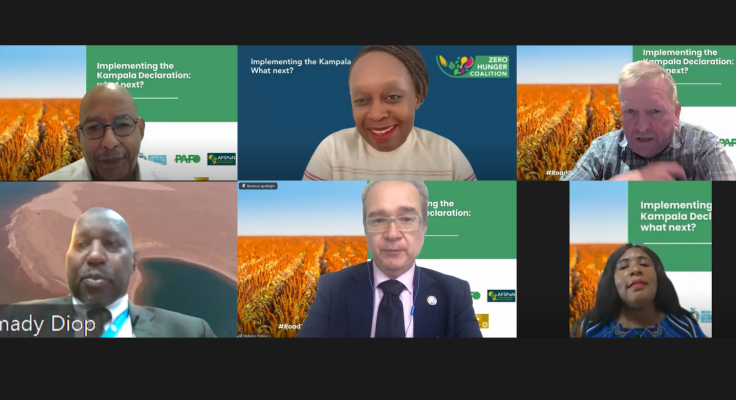Addressing risks in agriculture: strategies for mitigation, adaptation and resilience
In response to the growing challenges facing the agricultural sector, where climate shocks, market volatility and other risks increasingly threaten food security and farmer livelihoods, the Zero Hunger Coalition, in collaboration with the Platform for Agricultural Risk Management (PARM), organised a webinar to explore strategies for managing agricultural risks and enhancing resilience.
Risk is a concern for African agrifood systems. It undermines productivity, deters investments and leaves farmers—especially smallholders—exposed to repeated losses. Managing these risks is not just about responding after disasters strike—it requires acting post-ante: anticipating threats, reducing vulnerability, and investing in systems that protect and empower farmers over the long term.
As Francine Picard of the Shamba Centre for Food & Climate aptly noted during the event, “Anticipating climate, economic, health, or social shocks is not just about protection—it’s about giving farmers the tools to recover and grow. Risk management must be at the heart of resilient and forward-looking agricultural systems.”
The webinar placed particular emphasis on scalable solutions, such as agricultural insurance, that can help farmers absorb shocks, maintain income stability and invest in more productive practices.
The three-hour webinar brought together over 50 experts and policy makers for a series of presentations and group discussions. It is part of the Zero Hunger Coalition’s South-South dialogue series, which promotes peer learning and knowledge exchange between countries.
Agriculture is inherently risky
Agriculture plays a vital role in Africa. It contributes significantly to the GDP and provides livelihoods for a majority of the population. However, it remains highly vulnerable to a range of interconnected risks, including climate variability, extreme weather events, and economic instability, pest and political uncertainty, which threaten productivity and food security.
According to Francesca Nugnes, Capacity Development and Private Sector Specialist at PARM, risk can be caused by natural phenomena or human activity that results in material damage and/or loss of revenue. For agriculture, the impact is wide-ranging, affecting production and business operations as well as the financial and political environment. While risks carry substantial costs, they can also serve as catalysts for innovation and long-term resilience building—if managed effectively.
Adopting agricultural risk management tools
Agricultural risk management offers a structured and proactive approach to identifying, assessing, and addressing risks before they escalate into crises. This involves recognizing the interdependence of risks, actors, and solutions, and employing a multidimensional strategy that spans technical, financial, and institutional domains.
Access to accurate and timely information is critical for evaluating risk yet remains a challenge. For example, climate and weather forecasts may not be available without digital tools while pricing information may not be updated on a regular basis.
Solutions are diverse. They include on-the-farm solutions like climate-smart agriculture and crop diversification, as well as commercial and market mechanisms, such as agricultural contracts and commodity exchanges to help stabilise prices and secure reliable market access for producers. Financial and insurance tools include agricultural insurance schemes to provide farmers with protection against weather-related losses. Finally, government and social support solutions, including public food reserves, social protection programmes, and economic safety nets can provide critical support during times of crisis.
Focusing on agricultural insurance
Among the tools explored, agricultural insurance is designed to protect farmers from financial losses caused by unpredictable events. By paying a premium, farmers can secure compensation for crop failures, livestock losses, or natural disasters. Luc Sibbila Kafando, an expert in agricultural insurance and climate information systems at PARM, explained how this mechanism can stabilize farm incomes, facilitates access to credit, and enable investment in high-yield—but higher-risk—farming practices.
Two main types of insurance schemes were discussed: traditional insurance, which assesses direct damages before disbursing payouts, and index-based insurance, which riggers payouts based on pre-defined thresholds (i.e., rainfall levels or yield indexes) offering quicker and more transparent compensation.
Despite its benefits, agricultural insurance remains underutilized due to several barriers: high premiums, low farmer awareness, limited trust in insurance providers and financial exclusion in rural areas. Unlocking its potential will require government support, legal and institutional reforms and targeted capacity building for both insurers and farmers.
Agricultural insurance cannot be a standalone solution, noted Mr Kafando. It should be integrated into broader risk management strategies that engage governments, donors and the private sector as well as farmers’ organisations.
Highlights from the group discussions
Participants split into three groups to explore the implementation of agricultural risk management tools on the ground.
Encouraging farmers to adopt agricultural insurance
How can governments promote agricultural insurance, particularly among small-scale farmers? Policy recommendations include linking access to agricultural credit with participation in risk management schemes; introducing taxes on agricultural products to fund risk-sharing mechanisms; and subsidizing insurance premiums, particularly for the most vulnerable groups.
Capacity building is key, and participants stressed the importance of training farmers on insurance benefits. A case study from Senegal illustrated a successful example by establishing funds to subsidize premiums, forming public-private insurance partnerships, and improving agricultural credit conditions with lower interest rates.
Leveraging agricultural cooperatives and associations
The discussion underscored the significant role of agricultural cooperatives and farmer associations in facilitating access to risk management tools and insurance. These organizations serve as key knowledge-sharing platforms, helping farmers pool resources, negotiate better financial terms, and improve their resilience to shocks. By collecting and analysing localised data, cooperatives can enhance preparedness and advocate for policies that benefit their members.
Governments should support these organisations with technical training and resources, empowering them to conduct awareness campaigns on risk management. A collaborative model involving cooperatives, government agencies, and insurance providers was recommended to streamline the adoption of agricultural risk management tools.
Public policies to support agricultural risk management
Public policy has a key role in encouraging farmers to adopt agricultural risk management tools. These include raising awareness about agricultural insurance from an early age to embed a culture of risk management; establishing dedicated insurance funds to provide coverage in the event of natural disasters; and supporting cooperatives through training, digital infrastructure and market access.
Participants also recommended government-backed subsidies to lower insurance premiums and strengthening legal and institutional frameworks to attract private insurers and ensure a sustainable and competitive insurance market.
As participants regrouped to share the outcomes of their discussions, the webinar moderator, Lié Maminiaina from the Shamba Centre for Food & Climate, stressed the importance of a comprehensive and coordinated approach to agricultural risk management. This includes blending insurance mechanisms with climate adaptation, financial tools, and enabling policies. As she noted, strengthening legal frameworks and government awareness about available solutions expanding financial accessibility, and increasing farmer education are essential to building a resilient agricultural sector across Africa.



